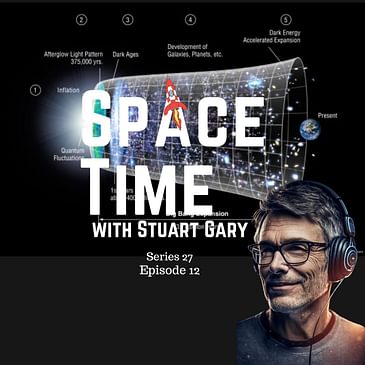The Space News Podcast.
SpaceTime Series 27
Episode 12 *The oldest black hole ever observed Astronomers have discovered the oldest black hole ever observed dating back more than 13 billion years to a time near the dawn of the universe. *New satellite to study Earths changing frozen regions The countdown is now underway for this year’s launch of the joint American Indian NISAR spacecraft which will study how climate change is affecting the planet’s ice sheets, glaciers, and sea ice. *Starliner parachute upgrade test Engineers have tested a new modified parachute system for Boeing's trouble plagued Starliner spacecraft in the skies above Arizona. *The Science Report Researchers have identified a 288 million year old fragment of ancient fossilized skin. Scientists create the largest ever catalogue of marine microbes based on scanning environmental DNA. New study looks at the microbes responsible for the lovely flavours of the cheddar cheese on your toast. Skeptics guide to favourite colour-based personality tests https://spacetimewithstuartgary.com https://bitesz.com Listen to SpaceTime on your favorite podcast app with our universal listen link: https://spacetimewithstuartgary.com/listen and access show links via https://linktr.ee/biteszHQ For more SpaceTime and show links: https://linktr.ee/biteszHQ
For more podcasts visit our HQ at https://bitesz.com
Your support is needed... **Support SpaceTime with Stuart Gary: Be Part of Our Cosmic Journey!** SpaceTime is fueled by passion, not big corporations or grants. We're on a mission to become 100% listener-supported, allowing us to focus solely on bringing you riveting space stories without the interruption of ads. 🌌 **Here's where you shine:** Help us soar to our goal of 1,000 subscribers! Whether it's just $1 or more, every contribution propels us closer to a universe of ad-free content. **Elevate Your Experience:** By joining our cosmic family at the $5 tier, you'll unlock: - Over 350 commercial-free, triple episode editions. - Exclusive extended interviews. - Early access to new episodes every Monday. Dive in with a month's free trial on Supercast and discover the universe of rewards waiting for you! 🌠 🚀 [Join the Journey with SpaceTime](https://bitesznetwork.supercast.tech/) 🌟 [Learn More About Us](https://spacetimewithstuartgary.com) Together, let's explore the cosmos without limits!
Become a supporter of this podcast: https://www.spreaker.com/podcast/spacetime-with-stuart-gary--2458531/support.





